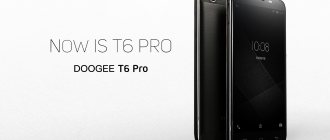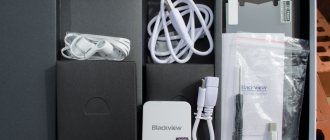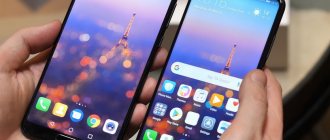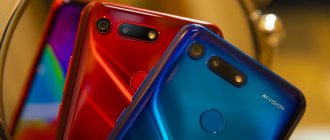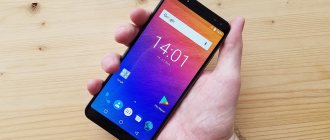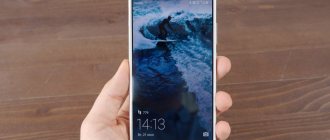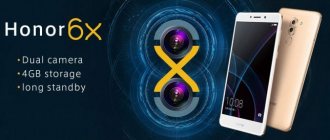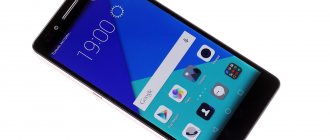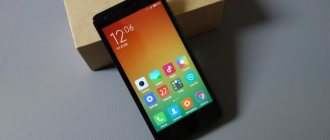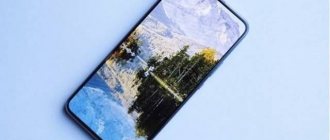Specifications
- Screen: IPS, 5.5″, Full HD, multi-touch support, up to 5 touches
- Processor: MediaTek MT6735M, 4 Cortex-A53 cores at 1.44 GHz.
- Technical process: 28 nm.
- Graphics accelerator: Mali-T720R.
- Operating system: Android 6.0 with minor changes to the UI.
- RAM: 2 GB.
- Built-in memory: 16 GB, supports microSD memory cards up to 256 GB.
- Communication: 850/900/1800/1900 MHz, UMTS 900/2100 MHz, LTE 1, 3, 7, 8, 20.
- SIM: 2 microSIM, Dual SIM Dual Standby.
- Wireless interfaces: Wi-Fi 802.11 b/g/n, Bluetooth 4.0, GPS
- NFC: none.
- Cameras: 2 main, main - 16 MP, front - 8 MP.
- Front camera: 8 MP.
- Sensors: proximity, accelerometer.
- Battery: 3300 mAh, non-removable.
- Dimensions: 77 x 156.6 x 8.7 mm.
- Weight: 154 g
Characteristics of Doogee Shoot 1 in detail
Platform
Chipset Mediatek MT6737 Quad core CPU 4 x ARM Cortex-A53 @ 1.30 GHz 64-bit Yes GPU ARM Mali-T720 MP2 @ 550 MHz NPU No Process technology 28 nm
Memory
RAM 2 Gb - LPDDR3 @ 640 MHz (Single Channel) Built-in storage 16 Gb - eMMC 5.0 Memory expansion Yes Memory card types microSD, microSDHC, microSDXC Maximum capacity 256 Gb Dedicated slot No data
Screen
Resolution 1080 x 1920 (FullHD) Aspect ratio 9:16 Matrix type IPS Diagonal 5.5″ Area ~83.4 cm2 Fill percentage ~69.2% (of the total front surface area) Pixel density ~401 ppi Security Yes
Connection
Communication standards GSM, UMTS, LTE 2G GSM 850/900/1800/1900 MHz 3G UMTS 900/2100 MHz 4G LTE FDD-LTE 800/900/1800/2100/2600 MHz LTE support Yes LTE categories Category-4 LTE speed Up to 150 Mbps in download mode, up to 50 Mbps in upload mode LTE device categories indicate the maximum speed at which it can send and receive data on 4G LTE networks through carrier aggregation. Number of SIM cards 2 Type of SIM cards Micro SIM
Cameras
Main camera
Type Dual Resolution 8.0 Mp + 13.0 Mp Autofocus Yes Aperture No data Flash LED
Front-camera
Resolution 8.0 MP Aperture No data
Interfaces
WiFi IEEE 802.11 a/b/g/n, 2.4 GHz, Wi-Fi Direct, DLNA, Wi-Fi access point mode is a technology for building wireless local networks based on the IEEE 802.11 family of standards. Supported by all modern smartphones and many mobile phones. Bluetooth v4.0 Bluetooth is a universal wireless interface for exchanging data between various types of devices at close range. Can be used for file transfer, audio streaming, network connection, printing and other purposes. The newer the version, the greater the speed and number of supported profiles. Navigation GPS, A-GPS, GLONASS For at least 10 years, smartphones have supported the geolocation function using data from satellite navigation systems. At the moment, these are the American-developed GPS, the Russian GLONASS, the Chinese BeiDou and the European GALILEO. As a rule, smartphones support the first two and optionally the rest. NFC No The built-in NFC module of a smartphone is mainly used for contactless payment in applications like Google Pay and Samsung Pay. Can also be used to read data from contactless cards, transfer files, etc. Read more here. Infrared port No Some smartphones have a built-in IR port. In the past, it was used to synchronize data both between two mobile phones and between a phone and a PC. However, now, due to its low speed, the infrared port is used mainly to control external devices in remote control mode. FM radio No Built-in radio receiver that allows you to listen to radio stations operating in the FM range. In most cases, it only works when headphones are connected, since the wire is used as a communication antenna. However, there are devices with a built-in antenna. 3.5 mm audio Yes Standard audio jack for connecting wired headsets and headphones. Starting in 2020, some smartphone manufacturers, following Apple, began to abandon it. In this case, to connect regular headphones, you need a special adapter for Lightning/USB Type-C. USB Micro USB, On-The-Go The type of USB connector installed in the smartphone and the capabilities it supports.
Sensors and biometrics
Sensors Light sensor, Electronic compass, Geomagnetic Sensor, Gravity sensor, Proximity sensor Fingerprint scanner Yes Scanner location On the back of the case Scanner reaction time No data Face scanner (Face ID) No Iris scanner (IRIS) No
Power supply
Battery capacity 3300 mAh Battery type Li-ion Removable battery No Fast charging No Wireless charging No
Software
Operating system Android 6.0 Marshmallow Shell No Over-the-air (OTA) update Yes Sending messages SMS, MMS, Email, Push Email, IM Internet browser HTML5, CSS, JavaScript Audio formats AAC, AMR, FLAC, M4A, MKA, MP3, WAV Video formats 1080P, ASF, FLV, MKV, MP4, RM, RMVB, WMV Graphic formats BMP, GIF, JPEG, PNG Voice assistant Google Assistant
Physical parameters
Dimensions 156.6 x 77.0 x 8.7 mm Weight 167 g Package dimensions 177.0 x 97.0 x 53.0 mm Package weight 383 g Protection class No Colors Black, Golden, Gray
Performance
Geekbench No AnTuTu data 38654 points Performance rating of Doogee Shoot 1 according to the popular AnTuTu benchmark.
Average data are shown. PassMark No data Important note : unfortunately, we cannot guarantee 100% accuracy of all data presented on this page, but we are constantly working in this direction. If you notice an error in the device settings, we will be very grateful if you report it in the comments.
Top
Contents of delivery
The smartphone arrived for review in its original box. Black, compact, but not very minimalistic in appearance.
Despite the compact packaging, Doogee was able to supplement the kit with several pleasant bonuses. These include a silicone case with plugs for the USB and mini-Jack input, a protective film already glued to the display and another spare film. The included cable and power supply seem very durable.
No headphones or any stickers were found during unpacking, but this can easily be forgiven for a smartphone in an extremely budget price category.
Appearance
The designers did not decide to come up with something new, so the appearance of the smartphone, in general, shows the features of OnePlus 3T. Whether this is a plus or a minus is up to the buyer to decide, but the smartphone itself, considering its price, looks pretty nice.
The front part of Doogee Shoot 1 is devoid of any inscriptions or logos of the company itself. Above the display there is a front camera, an earpiece and several sensors that allow the smartphone to automatically adjust the screen backlight level.
The display of the device, which occupies most of the front side of the device, is covered with the now popular glass with edges rounded to the edges. The bezels around the screen are quite large considering its size. If designers made them smaller, there would be an order of magnitude fewer complaints about the appearance of the smartphone. And in the hand, due to the reduced width, it would lie much nicer.
Just below the display are three physical navigation buttons. The Home button, which is also a fingerprint scanner, protrudes slightly above the overall surface of the front panel and is slightly loose. In order to make a full press, you will have to make a considerable effort, especially if you are holding the device with one hand.
On the plastic back of the smartphone there are two camera modules, a double flash and the logo of the company itself. It is obvious that the designers have succumbed to the fashion for the arrangement of plastic inserts on metal cases. Here, stripes of a different color are also present, but they do not have any practical application.
Initially, it seems that the back cover cannot be removed. However, if you pick it up with something thin and flat, you can still remove it. Below it is a non-removable battery, which indicates its capacity, and an open coaxial cable. Its manufacturer did not decide to hide the “insides” of the smartphone under plastic panels that protect it from external influences.
On the end sides of Doogee Shoot 1 there were only a volume rocker, a SIM card tray and a smartphone lock button (also the on and off button).
Design Doogee Shoot 1
When you first get acquainted with the phone, you get the impression that its body is made of high-quality metal. But in fact, plastic was used, externally stylized as metal thanks to a special finish. When purchasing, you will have a choice of three available colors - black, gray and gold. The Doogee Shoot 1 smartphone review revealed external similarities with the latest Huawei models, from which the manufacturer clearly drew inspiration. The result was not particularly impressive - the design can’t surprise anyone, but I wouldn’t dare call it bad either.
The front panel has 2.5D glass, under which there are two touch keys. Their functionality can be customized depending on personal preferences. There is a DTouch fingerprint scanner in the center between them; reading is fast, but touches are not always accurately recognized. The display is covered with an oleophobic coating, but its quality is far from ideal - the glossy surface collects fingerprints well and to make the device look beautiful, you have to constantly carry a cloth with you and wipe it. Above the display we will find a proximity sensor, an earpiece and an 8 MP camera module.
On the right is a power control key and a tray in which you can install two SIM cards or one microSIM and a memory card. The solution is atypical, because in place of the tray there is usually a volume key, which in our opinion would be more convenient.
On the left side we see a volume rocker.
At the bottom there is a grille for a multimedia speaker and microphone. A microUSB port is installed in the center between them.
At the top is the input for the headset.
Doogee Shoot 1 black review showed that the back panel is made of plastic. From the first days it is better to use the supplied case or your own, as the surface quickly becomes covered with prints. The main camera modules protrude somewhat from the body, and between them the manufacturer installed a two-section flash. The company logo flaunts in the center.
The case is plastic, but despite this, the smartphone is comfortable to use. It fits well in the hand and does not slip out; the only drawback is that it gets dirty. It will not always be convenient to operate the phone with one hand, because with a diagonal of 5.5 inches it is not so easy to reach the top icons. But there is one interesting solution - one-handed control mode, in which you can reduce the working area of the screen. Regarding the build quality, everything is excellent.
Display
Doogee Shoot 1 is equipped with an IPS display module manufactured by Sharp with Full HD resolution. A good choice, providing a relatively clear picture with almost adequate color rendition.
The black color does not look as dark as I would like. This is especially noticeable if you look at the screen at an angle of 45-50 degrees. The all dark color palette begins to invert slightly. This problem is not observed with other colors.
The viewing angles are large, colors, except black, do not change even at maximum values. A good indicator for a budget display module, given that there is a small air gap.
The minimum and maximum brightness levels are optimally selected by the manufacturer. In a dark environment, the screen does not “hit” the eyes, and in conditions of sufficient lighting and direct sunlight, the desire to increase the brightness does not arise.
The glass covering the entire front surface most likely does not have an oleophobic coating, or its layer is very small. There are almost no fingerprints left, but the tactile sensations when touched are not what they should be with such a coating.
Testing the maximum number of touch points on the screen gave a completely expected and standard result for a device of this class - 5 touches.
Review of the DOOGEE Shoot 1 smartphone - an interesting smartphone with two cameras
Today I have prepared a review of a rather interesting smartphone DOOGEE Shoot 1, which, despite its low cost, borrowed its design and some functions from its more expensive counterparts. Let's take a closer look at this model together and find out what the small Chinese company got out of this idea!
Main characteristics: OS: Android 6.0 Screen: 5.5 inches, Sharp IPS FullHD 1920*1080 Processor: MediaTek MT6737T, 1.5 GHz, Quad core Graphics accelerator: Mali-T720 MP2 RAM: 2 GB Built-in memory: 16 GB Cameras : main - dual 13 MP + 8 MP, front - 8 MP Slots: micro-SIM + micro-SIM or microSD Memory card support: microSD up to 256 GB Communications: 2G: 850/900/1800/1900 MHz, 3G: 900/ 2100 MHz, 4G: 1, 3, 7, 8, 20 Wireless interfaces: WiFi 802.11a/b/g/n/ac, Bluetooth 4.0 Navigation: GPS (A-GPS), GLONASS Battery: 3300 mAh Dimensions: 156.6 *77.2*9.3mm Weight: 169g
Equipment The smartphone is sold in a fairly decent package with high-quality printing, like for a state employee, so it’s not a shame to give one as a gift. 
In the standard kit we receive: a smartphone with a protective film on the screen, another film with a cloth for the screen, a charger, a USB cable, a soft bumper and waste paper.
Appearance The smartphone is available in three colors.
Looking at the promotional photo, you might think that the smartphone’s body is metal, it’s very similar to the current trendy “all-metal” design of expensive models. And upon a quick inspection, for example, in the hands of another person, you might think the same thing, but no, after all, the body of the smartphone is made of plastic painted to look like metal, but of quite high quality. The front side of the smartphone is covered with 2.5D glass. At the bottom center there is a fingerprint sensor, which is also a mechanical button, and on the sides there are two touch buttons, they are not backlit. On top there are sensors, a camera and an earpiece. The event indicator, unfortunately, was sacrificed to reduce the cost of the smartphone. The back side, as we have already found out, has a non-removable plastic cover.
And upon a quick inspection, for example, in the hands of another person, you might think the same thing, but no, after all, the body of the smartphone is made of plastic painted to look like metal, but of quite high quality. The front side of the smartphone is covered with 2.5D glass. At the bottom center there is a fingerprint sensor, which is also a mechanical button, and on the sides there are two touch buttons, they are not backlit. On top there are sensors, a camera and an earpiece. The event indicator, unfortunately, was sacrificed to reduce the cost of the smartphone. The back side, as we have already found out, has a non-removable plastic cover. There are two cameras, a flash and an additional microphone, the DOOGEE logo, as well as a proud inscription that the smartphone was designed in Spain! On the right side we have a combined slot for two micro-SIM or micro-SIM + microSD and a power button just below.
There are two cameras, a flash and an additional microphone, the DOOGEE logo, as well as a proud inscription that the smartphone was designed in Spain! On the right side we have a combined slot for two micro-SIM or micro-SIM + microSD and a power button just below.
A volume rocker is installed on the left side. At the bottom there are two sets of holes (but there is only one speaker and it is located on the left), a micro-USB connector and a microphone.
At the top there is a lonely headphone jack.
And here I must note that I really liked the design of the smartphone, because it is similar to my main and favorite smartphone OnePlus 3 Well, except that the frames around the display are not so thin and the overall dimensions are a little larger... Next, let’s take measurements: And let’s see how it sits bumper included: Screen The smartphone has a 5.5-inch IPS matrix manufactured by SHARP with Full HD 1920*1080 resolution, the sensor processes up to 5 simultaneous touches. The quality of the picture pleasantly surprised me from the first glance at the desktop; I did not expect such a picture from a Chinese budget employee, although recently I have tested similar models from others class=”aligncenter” width=”685″ height=”456″| fcw3qayjh5a| src=»https://www.taker.im/up/2017-03-01/14883821909712929120o.jpg» class=»aligncenter» width=»1600″ height=»1066″[/img] The matrix here is really high quality, under corners are not blue, the colors are very saturated and do not lose their effect at low brightness values, and the black color has a certain depth, almost like on Amoled. I even wanted to visually compare the screen of the smartphone under review with my OnePlus 3. It, of course, loses a little in maximum brightness, but otherwise it’s not bad.
Well, except that the frames around the display are not so thin and the overall dimensions are a little larger... Next, let’s take measurements: And let’s see how it sits bumper included: Screen The smartphone has a 5.5-inch IPS matrix manufactured by SHARP with Full HD 1920*1080 resolution, the sensor processes up to 5 simultaneous touches. The quality of the picture pleasantly surprised me from the first glance at the desktop; I did not expect such a picture from a Chinese budget employee, although recently I have tested similar models from others class=”aligncenter” width=”685″ height=”456″| fcw3qayjh5a| src=»https://www.taker.im/up/2017-03-01/14883821909712929120o.jpg» class=»aligncenter» width=»1600″ height=»1066″[/img] The matrix here is really high quality, under corners are not blue, the colors are very saturated and do not lose their effect at low brightness values, and the black color has a certain depth, almost like on Amoled. I even wanted to visually compare the screen of the smartphone under review with my OnePlus 3. It, of course, loses a little in maximum brightness, but otherwise it’s not bad.
For those who like to play with the settings or who do not like the default very colorful screens, the firmware includes MiraVision and LiveDisplay utilities. Almost all users of smartphones on MTK chips are familiar with the first, and the second not only allows you to calibrate the colors on the screen, but also set the overall color temperature and automatically apply one value for daytime and another for nighttime. Hardware and general operating impressions The smartphone is built on a quad-core MTK6737T chip with increased frequencies of up to 1.5 GHz and has 2 GB of RAM. This is already “standard” hardware for Chinese mid-budgeters and is practically the minimum required today for comfortable work with many applications. The smartphone has the following sensors installed and working properly: lighting, proximity, orientation, accelerometer and magnetic field sensor. The internal memory capacity is 16 GB, and about 11 of them are available to the user at startup. MicroSD cards up to 256 GB are also supported, but only as a replacement for a second SIM card. In synthetic tests, the smartphone does not score very high. But this does not mean that in addition to making calls, for example, you can only read social networks. It copes with playing both offline and online videos in 1080p quality without a hitch, and also allows you to play most modern games, except perhaps the most demanding ones. For a comfortable game you need to set the settings to minimum. Fingerprint scanner In this model, the scanner is located in front under the screen.
Almost all users of smartphones on MTK chips are familiar with the first, and the second not only allows you to calibrate the colors on the screen, but also set the overall color temperature and automatically apply one value for daytime and another for nighttime. Hardware and general operating impressions The smartphone is built on a quad-core MTK6737T chip with increased frequencies of up to 1.5 GHz and has 2 GB of RAM. This is already “standard” hardware for Chinese mid-budgeters and is practically the minimum required today for comfortable work with many applications. The smartphone has the following sensors installed and working properly: lighting, proximity, orientation, accelerometer and magnetic field sensor. The internal memory capacity is 16 GB, and about 11 of them are available to the user at startup. MicroSD cards up to 256 GB are also supported, but only as a replacement for a second SIM card. In synthetic tests, the smartphone does not score very high. But this does not mean that in addition to making calls, for example, you can only read social networks. It copes with playing both offline and online videos in 1080p quality without a hitch, and also allows you to play most modern games, except perhaps the most demanding ones. For a comfortable game you need to set the settings to minimum. Fingerprint scanner In this model, the scanner is located in front under the screen.
I have no complaints about its work; recognition almost always happens the first time. It is also a touch button that responds to touch, as well as a physical “Home” button. In the settings, you can activate the functions that touching the scanner can perform in different applications. Interface The smartphone firmware is based on Android 6.0 OS. Everything in the upper curtain is standard, but the firmware also has, so to speak, a lower curtain, which can be called up by swiping from below and provides quick access to some settings and recently used applications. In terms of pre-installed programs, the firmware is not entirely clean. There are several useful applications installed here, for example, WPS Office. But there is also a seemingly harmless application called 2 Accounts, which is designed for using a smartphone under different accounts. It turned out to consume excessive power even in standby mode and constantly uses WiFi. It cannot be removed, but it can be stopped and disabled. The settings menu also differs from stock. There is an option to speed up the loading of Turbo download files, advanced gesture control settings, a QR code scanner, a built-in Power saver application, a flashlight, settings for the emergency message function, one-handed control mode and the DG security “security center”. As expected, the firmware has an over-the-air update function and it works. Lately I have received as many as 4 small updates. I don’t know all the fixes in them, but a bug with a decrease in battery charging current when the smartphone is active was definitely fixed, and work was done to reduce power consumption in standby mode.
Communications, wireless capabilities, multimedia The smartphone has a dual slot for micro-SIM cards.
Supported frequencies: 2G: 850/900/1800/1900 MHz, 3G: 900/2100 MHz, 4G: Band 1, 3, 7, 8, 20 I did not find any problems with signal reception. The speaker and microphone provide good call quality in both directions. The external speaker produces decent “budget” sound, but if you turn on volume boost in the settings, wheezing may appear at maximum. The sound in the headphones here is almost typical for a budget phone; you can play with its settings in the built-in equalizer. Wireless interfaces Bluetooth 4.0 and WiFi 802.11a/b/g/n/ac did not cause any complaints. WiFi data transfer speeds are slightly higher when using the 5 GHz frequency. For navigation, the smartphone uses satellites of two GPS and GLONASS systems. He “sees” quite a lot of them even in cloudy weather and writes quite real tracks. Camera In tribute to the current fashion, the smartphone is equipped with two main Samsung cameras 13 MP + 8 MP, and one front 8 MP. The camera app is almost stock with some features added. The camera takes photos of average quality (the macro is good, but long-range photos often lack sharpness) and can take pictures in blur mode using two cameras, which make it possible to visually highlight the desired object, and shoots video in resolutions up to 1080p. Some examples: HDR:
Photos from the front: Originals.
Battery and tests The smartphone is equipped with a non-removable battery with a declared capacity of 3300 mAh. It comes with a good quality charger and cable.
The smartphone charges quite quickly with a current of about 1.5 A and gains a capacity value similar to the declared one. Battery tests also show the expected results for this capacity and quite good results. In the Antutu Battery 80% test at full screen brightness, the smartphone earned 6037 points, and the test itself lasted about 3.5 hours. In 3D games, judging by the results of the GameBench application, the smartphone can last up to 4 hours at medium brightness. An hour of watching Youtube videos at medium brightness and sound consumes about 16% of the charge. Let's summarize.
I believe that Doogee managed to realize a good price/quality ratio in this model. In DOOGEE Shoot 1 we got a good appearance, a screen that is simply excellent for this price category, a normal battery, and standard hardware for state employees that just works well. My only criticism would be the quality of general shots with the camera; it copes quite well with macro and effects shots. In addition to everything, you can give a plus to the manufacturer for supporting its new model and fairly quickly releasing updates with fixes, which, you see, is rare in the budget segment. So, perhaps the camera software will be improved someday.
Thank you for your attention and see you soon!
Fingerprint's scanner
A huge plus for Doogee Shoot 1 was the location of the scanner. Not at the back, as engineers and designers usually place it in budget models. Here, the scanner is integrated into the Home button, making it easier to unlock the device.
The budget nature of the smartphone makes itself felt precisely in the operation of the scanner. He's not slow, but he can't be called fast either. Since fingerprint recognition does not always happen the first time, the most convenient solution was to repeatedly add the same fingerprint, but from different angles. So the chance of successful unlocking has increased and it has become very convenient to use.
The Home button, which is home to the scanner, has a touch layer that eliminates physical pressing, replacing it with any navigational interaction with the system. It’s quite a convenient feature, but it’s slightly overshadowed by the incompletely thought-out concept of the key itself. It would be optimal to make it only sensory, leaving no possibility for its mechanical operation. And this is not so difficult to implement.
Equipment and appearance
DOOGEE Shoot 1 comes with a charger, USB cable, protective film, screen cleaning cloth and silicone case. All this is packaged in a neat black box with a picture of the phone.
At first glance at the smartphone, it may seem that its body is made of good metal. Some online publications also point out this in their reviews, which is not entirely true. Only plastic was used in the manufacture of the case, which looks like metal due to its special finish. There are three colors to choose from – black, gold and grey.
Chinese designers were guided by the style of Huawei devices when developing the appearance of Shoot 1. The result turned out to be very inconspicuous; the smartphone cannot boast of beauty or any non-standard solutions in the assembly.
There is 2.5D glass on the front panel of the phone, there are two touch keys at the bottom of the screen, their functions can be customized. The DTouch fingerprint scanner is also located here. It's very fast, but sometimes it doesn't work when the display is off. First you have to “wake up” the phone with the power button. The quality of the oleophobic coating is very mediocre - the glossy front surface is easily stained by fingerprints. On top, above the screen, there is a proximity sensor, an 8 megapixel camera and a speaker.
On the right panel of the smartphone there is a screen off button and a combined slot for SIM cards. The user can insert a Micro SD or leave two microSIM cards. At first glance, there are noticeable flaws in the design of the tray; it does not fit into the overall appearance of the device. This practice is not surprising for cheap Chinese brands.
On the left is the volume rocker.
There are two speaker grilles at the bottom, but there is only one speaker itself. The second one is located close to the main camera. There is also a microphone and a micro-USB connector.
On the top edge of the smartphone there is an output for 3.5 mm headphones.
The back surface is made of plastic. The material quickly collects smudges and fingerprints. The two main cameras protrude slightly beyond the body; a flash is placed between them. The company logo is printed just below. The smartphone is not separable.
Despite the plastic body, the smartphone is very ergonomic and fits perfectly in the hand. During the entire period of use, I did not feel any obvious discomfort, except for the difficulties when controlling the smartphone with one hand. Because of the 5.5-inch screen, it is sometimes difficult to reach the desired icon with your finger. For such cases, Shoot 1 provides a “one-handed” mode, which is activated after double-clicking the main key. In general, no significant shortcomings were noticed; the smartphone was assembled quite well.
Operating system and software
Doogee Shoot 1 runs on the now widespread Android 6.0 with a minimum of interface changes, but with a lot of additional functions that sometimes we would like to see more often in smartphones from A-brands.
Apart from some icons that mysteriously migrate from older versions of Android, there are no significant “innovations”. The manufacturer did not customize the shell in any way, leaving almost everything in its place.
The standard launcher has a rather interesting feature. Swiping up from the bottom edge of the screen blurs the background and the user is presented with an analogue of the bottom bar in iOS, which is called in the same way. Here you can adjust the brightness of the display, switch to one of the recent offers, or activate airplane mode.
The utility for creating screenshots also deserves attention, allowing you to take long screenshots (similar to MIUI8), select the most necessary field with a rectangular selection, or select the desired area with your finger.
Sometimes in the settings there are poorly translated menu lines, in the words of which there are small errors, more like typos. Most likely, this is due to the lack of Russian-speaking testers of our own firmware.
Performance
It makes no sense to expect high results from a smartphone that costs almost seven thousand rubles when tested in various benchmarks. It easily copes with rendering interface animations, there are no problems when scrolling through the desktop, and even applications open, in general, quickly.
In the popular synthetic test from AnTuTu, Doogee Shoot 1 with a quad-core MediaTek MT6737T (clock frequency 1.5 GHz) scored almost 40,000 points. Not a bad result for a budget device.
This is what the test results look like in other mobile benchmarks:
In games, the results were somewhat encouraging. At the highest available settings in Asphalt Xtreme, the smartphone produces stable 30-40 frames per second without visible drops. The graphics in Doogee Shoot 1 are controlled by the Mali-T720-MP2 graphics accelerator, which is enough for simple tasks.
In platformers and simple games, problems obviously do not arise. 2 GB of RAM allows lightweight applications to stay in memory without being suddenly unloaded. For this we must pay tribute to the firmware developers.
Advantages and disadvantages of Shoot 1 phone
Doogee Shoot 1 measures 77 mm wide, 156.6 mm long and 8.7 mm thick. With such dimensions it is convenient to operate the device with one hand. In addition, the weight of the device is about 154 g. Even if you operate the device with one hand, its weight is almost not felt.
If we evaluate the overall ease of use of the phone taking into account the size and weight, then there will be no problems with everyday use.
The smartphone is equipped with a 4-core MediaTek MT6737T processor, which is made at 28 nm. technical process.
The smartphone has 2 GB. RAM, which is quite enough. In very rare cases it will not be enough, but with this amount of RAM, you will rarely have problems.
The device's data storage capacity is 16 GB, and while this is enough for photos, it may not be enough for video shooting and a large number of games.
The phone is compatible with SD cards, so you can easily expand its memory. So you probably don't need to worry about storage capacity.
Shoot 1 has a 5.5-inch display diagonal. It's quite big. Photos, videos and games will look great on this screen. It is also suitable for productive use, such as creating a business document.
The smartphone has a high-end display and any graphic content you display on it, including videos and games, will be displayed clearly.
The main camera of the phone has 12.98 megapixels and can take high-resolution photos and videos. While you're shooting landscapes or printing high-definition photos, you may want a higher-resolution camera, but most of the time you'll be happy with the camera.
Also, the smartphone has a 7.99 megapixel front camera, which is average for smartphone cameras. This is good enough for taking selfies, but you may not be satisfied with group photos or their print quality.
The battery capacity of Doogee Shoot 1 is 3300 mAh, which is a relatively large indicator. Compared to other smartphones, the battery life of Doogee Shoot 1 is good. With this capacity, you won't experience any problems even if you spend time on the Internet or Twitter for a long period of time. Even while playing games or watching videos, you can do so comfortably without worrying about battery life. However, some caution should be exercised when watching movies or playing games for too long.
Connection
Doogee Shoot 1 supports the ability to use two SIM cards, which will allow the owner to stay connected, for example, where one operator may not provide reliable coverage. Both modules support the main Russian frequencies of fourth generation networks.
GPS does not work as well as we would like, connecting to three or four satellites in a few minutes. But this is enough for the smartphone to determine your exact location up to six meters when indoors.
Shoot 1 did not receive an NFC module. It's a pity. If equipped with a fingerprint scanner, the smartphone would become a means of paying for purchases using the Android Pay system, which recently came to Russia.
Autonomy Doogee Shoot 1
Recently, many Chinese public sector phones have been equipped with a high-capacity battery. As the Doogee Shoot 1 lte review in Russian showed, it was equipped with a 3300 mAh battery, which is enough with such a filling. Fast charging is supported via the included 5V/2A adapter. When tested with an active Wi-Fi connection, music and active use of programs, the smartphone lasted about 4 hours. With more gentle use, the charge will last until the end of the day. In video playback mode, the battery lasts for 8 hours.
Camera
Equipped with two main cameras made by Samsung, the budget camera phone demonstrates good photographic capabilities in normal lighting conditions.
There is no noise, good detail, but there is sharpening on small lines. It is especially noticeable when examining in detail the wires filmed on the street, although the resolution of the output images is 16 MP. An example of a photo taken in Blur mode, using two cameras at once.
The second camera is more of a marketing gimmick than an actual working solution for shooting background blur. The background is not completely blurred; the effect of an open aperture in a smartphone is most likely achieved through software. It’s easier to use a camera from Google, in which the background post-processing algorithms have been fine-tuned over the years and hardly raise any complaints.
The built-in camera application has a lot of different settings that can be used to get a better image depending on the lighting conditions of the frame. If you dig deeper, then in the engineering menu you can find a way to force the camera to shoot in DNG (standard digital negative format), but nothing is known about the consequences of such software intervention in this firmware.
Video shooting is mediocre. There is almost no stabilization even at the software level; with sharp wiring, horizontal or vertical artifacts are observed, depending on the direction of wiring.
The front camera, which shoots in 8 MP resolution, takes quite good pictures that can be published on social networks without hesitation.
Doogee Shoot 1 as a photo and video camera
| Rear: | 13 + 8 MP, AF |
| Front: | 8 MP, FF |
The main camera is double. The first camera films as usual. The second is used exclusively to create a bokeh effect, i.e. blur the background.
Examples of pictures are in front of you. Alas, everything is extremely weak. And these, as you understand, are still the most successful shots. We don't know how to take pictures on a sunny day. At night, by and large, too. Bokeh? In this case, it’s a one-time toy, excuse me. Here is a photo from the recommended distance of two meters. Well, where is the well-blurred background behind the person? On the sides - yes, on the sides everything was blurred as it should. Why not at the back? Such blurriness can just as easily be drawn in Photoshop. Why is there a second camera here?
I repeat. The camera is completely normal for a smartphone for this kind of money. And if this smartphone were not positioned as a photo smartphone, there would be no questions. And so - sorry...
More photos
More photos.
The front camera for a smartphone of this price is quite decent. But with a glitch. For some reason, some of the photographs turned out to be rotated and elongated. Of course, my face is not the widest, but still not that wide. Apparently it's a software glitch.
The front camera resolution officially specified by the manufacturer is 8 MP. In this case, photographs are obtained with a size of 4160x3120 pixels, i.e. 13 MP - interpolation...
